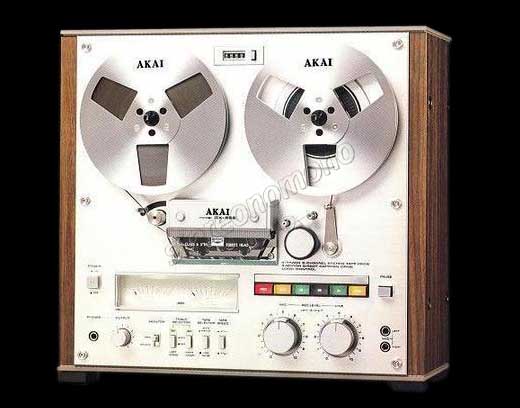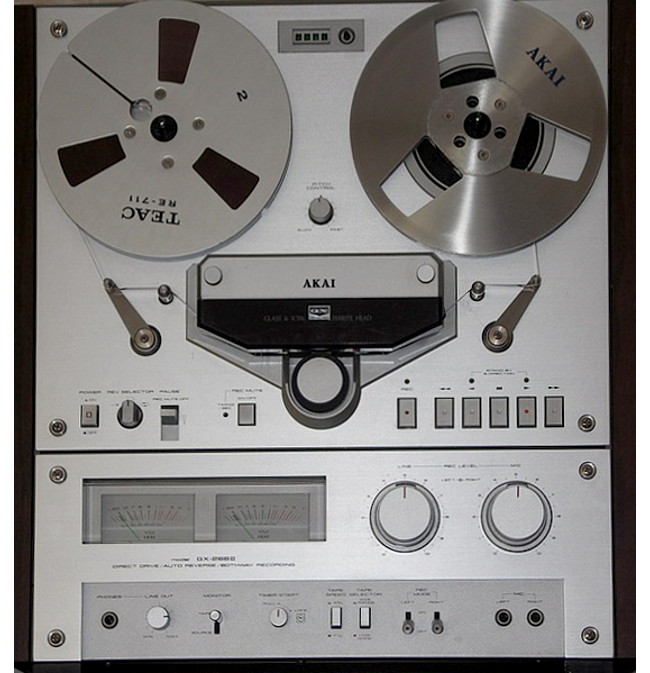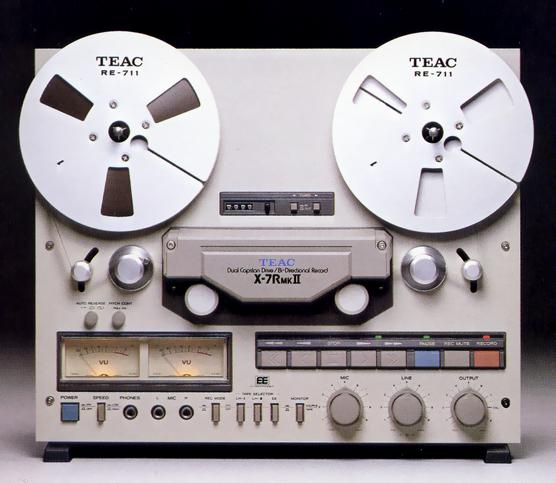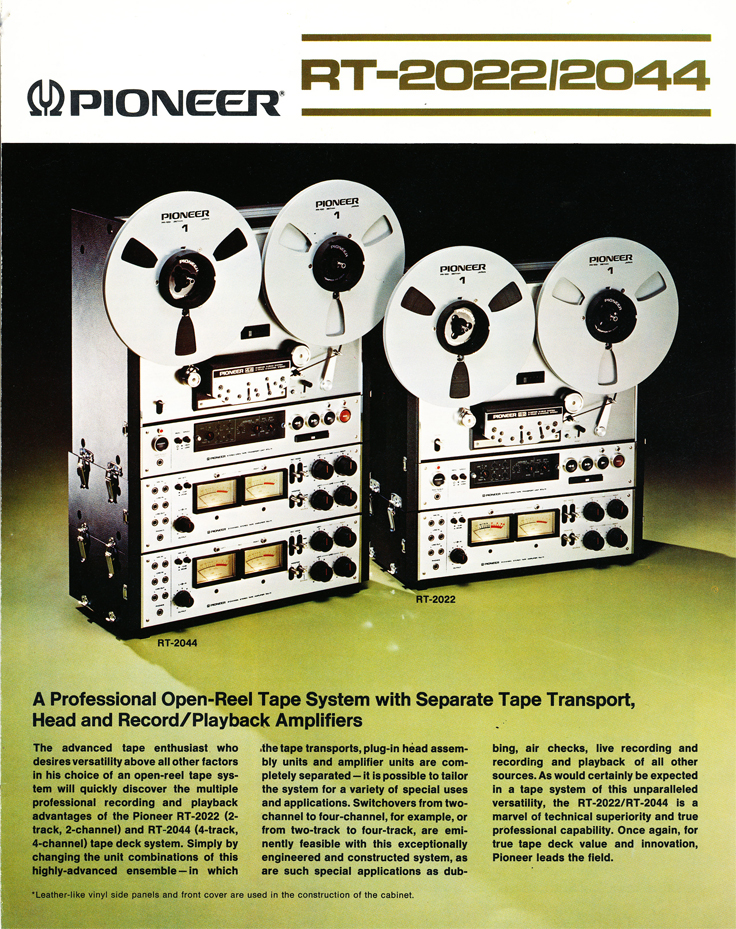MAGNETOFON ( reel to reel )
Re: MAGNETOFON ( reel to reel )
O solutie care se vehiculeaza pe forumuri, in special acum, dupa aparitia noilor benzi trase de pe mastere s.a.m.d - capete modificate, tape path modificate PLUS play amplifier pe lampi.
- http://tapeproject.com/machines/
- http://www.jrfmagnetics.com/ - citit totul, f. interesant, incl Nortronics heads
- http://www.fluxmagnetics.com/
- http://bottlehead.com/reel-to-reel/
- http://www.athan.com/cgi-local/store.cgi?cat1=1003
-
- http://tapeproject.com/machines/
- http://www.jrfmagnetics.com/ - citit totul, f. interesant, incl Nortronics heads
- http://www.fluxmagnetics.com/
- http://bottlehead.com/reel-to-reel/
- http://www.athan.com/cgi-local/store.cgi?cat1=1003
-
... living a vi(ntage)king analog lifestyle in a digital world ...
Re: MAGNETOFON ( reel to reel )
Da, merci Lektor, am mai invatat ceva, interesante Linkuri. Preturile sunt ca atare 3 capete pentru Ampex AG 440 C aproape 2000$ si piesele de Studer sunt si ele foarte scumpe, banuiesc ca sunt de USA. Aici in Europa se mai gasesc multe piese noi direct dela fabrica. Upgrade-urile pt maguri sunt, cred ca, pentru cei care nu au ce face cu banii.
Re: MAGNETOFON ( reel to reel )
MAGURI PE ROLE MICI 7" = 18cm
AKAI GX-255 - fratele mic al lui GX-620/625

AKAI GX-266 II

AKAI GX-77

Technics RS-777

TEAC X-7

AKAI GX-255 - fratele mic al lui GX-620/625

AKAI GX-266 II

AKAI GX-77
Technics RS-777
TEAC X-7
... living a vi(ntage)king analog lifestyle in a digital world ...
Re: MAGNETOFON ( reel to reel )
Frumoase si astea mici, zilele trecute cochetam sa iau un Tascam 22-2, pana la urma a invins intrebarea "unde o sa-l pui" si m-am lasat, si ca fapt divers chiar cu 10 minute in urma am inregistrat o banda ORWO de 40 de ani cu un studer b67 pe viteza de 19, 2 piste, si am ramas surprins ce calitate a avut inregistrarea, cu mici pierderi la inregistrare dar nu la calitate.
Re: MAGNETOFON ( reel to reel )
AKAI GX-255, fratele mic al lui GX-620/625 este autorevers! Adica reda in ambele directii si trage doar in cea principala. Eu cred ca puteau sa-l faca si pe GX 625 la fel, mai aveau loc sa indese un cap de redare.
Adaug la colectia de "pitici" expusa mai sus un european poate uratel dar construit formidabil (3 motoare din care doua DD si dotat cu Cross Field, greu de rupe, suna fantastic, trage fantastic, deruleaza fantastic! La sunet umileste japonachele de mai sus!... Apropos, era sa uit! Are volanta din .... cupru masiv!
Are volanta din .... cupru masiv!  ):
):

Adaug la colectia de "pitici" expusa mai sus un european poate uratel dar construit formidabil (3 motoare din care doua DD si dotat cu Cross Field, greu de rupe, suna fantastic, trage fantastic, deruleaza fantastic! La sunet umileste japonachele de mai sus!... Apropos, era sa uit!

Prostu' invata pe pielea lui, desteptu' pe-a altuia.
Re: MAGNETOFON ( reel to reel )
Stiu acel Tandberg, trageam cu Philips N4504 de pe el, la un amic.
X-FIELD - dezvoltat de Tandberg, dar folosit extensive de ... AKAI, in special prin brandul Roberts in SUA, anii 60-early 70.
" A cross-field head, sometimes referred to as X-field, is an additional recording head in a tape recorder that improves the ability to record high-frequency sounds. The concept was first introduced by Tandberg in their TB-6X 1960s, and more widely used by Akai and their US brand, Roberts.
A conventional tape recorder uses two heads. The main head is used for both playback and recording. A second head, placed before the main head in terms of the direction of tape movement, is used during recording to erase any previous signal. Additionally, the record head is used to introduce a tape bias signal that improves frequency response.
Generally, lower frequencies are recorded lower in the oxide layer on the tape. In order to get the bias signal into these layers, the signal has to be fairly strong, stronger than what would be needed to write higher frequencies alone. This means there is some stray signal, both from the bias and new high frequency signals being recorded, that "leaks out" of the immediate area of the recording and into the nearby tape. For low frequencies this has no effect because the layer they are recorded in is far from the record head, but for high frequencies it is possible to self-erase a signal just laid down.
This problem is primarily seen at slower tape transport. If the tape is moving at high speed the previously recorded sounds will quickly move away from the record head and avoid self-erasure. At slower speeds there isn't enough time for this to happen.
Cross-field recording adds a second head to record the bias signal separately from the signal. It is placed on the "back" of the tape, directly across from the recording head. Since the bias has to reach the deepest layers of the oxide, placing the head on the back of the tape means that reaching these levels does not require it to penetrate right to the front of the tape. This helps reduce self-erasure due to the bias signal.
Additionally, the heads are arranged so the combination of the two signals results in a small "dead zone" directly past the recording head where high frequency signals are blanked out. This prevents subsequent high frequency signals from interfering with those just recorded, by the time they exit the dead zone they are too far from the head to be overwritten.
Although the two-head solution was the first and most common type of cross-field system, there were several other systems of varying complexity and capability. Akai reel-to-reel systems using cross-field, starting with the Akai XIV/Roberts 770, boasted 13 kHz maximum frequency at 1.875 inches per second, greater than similar systems at twice that speed.
The two-head cross-field system also had problems. One was the need to keep the heads in proper alignment, which was tricky for the average user. Additionally, dirt on the tape of record head that lifted the tape away from the record head pushed it closer to the bias head, re-introducing the self-erasure problem. For proper results, cross-field recording needed high quality tapes, to ensure the oxide layer was thick enough to allow the bias signal to imprint on the deeper levels of the oxide without reaching the front surface. "

X-FIELD - dezvoltat de Tandberg, dar folosit extensive de ... AKAI, in special prin brandul Roberts in SUA, anii 60-early 70.
" A cross-field head, sometimes referred to as X-field, is an additional recording head in a tape recorder that improves the ability to record high-frequency sounds. The concept was first introduced by Tandberg in their TB-6X 1960s, and more widely used by Akai and their US brand, Roberts.
A conventional tape recorder uses two heads. The main head is used for both playback and recording. A second head, placed before the main head in terms of the direction of tape movement, is used during recording to erase any previous signal. Additionally, the record head is used to introduce a tape bias signal that improves frequency response.
Generally, lower frequencies are recorded lower in the oxide layer on the tape. In order to get the bias signal into these layers, the signal has to be fairly strong, stronger than what would be needed to write higher frequencies alone. This means there is some stray signal, both from the bias and new high frequency signals being recorded, that "leaks out" of the immediate area of the recording and into the nearby tape. For low frequencies this has no effect because the layer they are recorded in is far from the record head, but for high frequencies it is possible to self-erase a signal just laid down.
This problem is primarily seen at slower tape transport. If the tape is moving at high speed the previously recorded sounds will quickly move away from the record head and avoid self-erasure. At slower speeds there isn't enough time for this to happen.
Cross-field recording adds a second head to record the bias signal separately from the signal. It is placed on the "back" of the tape, directly across from the recording head. Since the bias has to reach the deepest layers of the oxide, placing the head on the back of the tape means that reaching these levels does not require it to penetrate right to the front of the tape. This helps reduce self-erasure due to the bias signal.
Additionally, the heads are arranged so the combination of the two signals results in a small "dead zone" directly past the recording head where high frequency signals are blanked out. This prevents subsequent high frequency signals from interfering with those just recorded, by the time they exit the dead zone they are too far from the head to be overwritten.
Although the two-head solution was the first and most common type of cross-field system, there were several other systems of varying complexity and capability. Akai reel-to-reel systems using cross-field, starting with the Akai XIV/Roberts 770, boasted 13 kHz maximum frequency at 1.875 inches per second, greater than similar systems at twice that speed.
The two-head cross-field system also had problems. One was the need to keep the heads in proper alignment, which was tricky for the average user. Additionally, dirt on the tape of record head that lifted the tape away from the record head pushed it closer to the bias head, re-introducing the self-erasure problem. For proper results, cross-field recording needed high quality tapes, to ensure the oxide layer was thick enough to allow the bias signal to imprint on the deeper levels of the oxide without reaching the front surface. "

... living a vi(ntage)king analog lifestyle in a digital world ...
Re: MAGNETOFON ( reel to reel )
Alti PITICI vestiti
PHILIPS N-7150 - aici voi sari peste seria PLASTIK

 - alde N45XX
- alde N45XX

PIONEER RT 707

AKAI GX-265

SONY TC-399

PHILIPS N-7150 - aici voi sari peste seria PLASTIK

PIONEER RT 707

AKAI GX-265

SONY TC-399

... living a vi(ntage)king analog lifestyle in a digital world ...
Re: MAGNETOFON ( reel to reel )
pana la urma sistemul Cross Field este mai bun decat teoria, in exploatarea reala. Insa Tandberg avand patent nu a permis ca acest sistem sa se raspandeasca wide world din pacate.LEKTOR wrote:The two-head cross-field system also had problems. One was the need to keep the heads in proper alignment, which was tricky for the average user. Additionally, dirt on the tape of record head that lifted the tape away from the record head pushed it closer to the bias head, re-introducing the self-erasure problem. For proper results, cross-field recording needed high quality tapes, to ensure the oxide layer was thick enough to allow the bias signal to imprint on the deeper levels of the oxide without reaching the front surface. "
Ceea ce a facut AKAI cu Cross Field este foarte slabut in comparatie cu Tandberg, drept dovada ca japonezii au si renuntat dupa putin timp.
exemplul dat de tine, N-7150 este culmea plasticului, bomba suprema! Defapt cele doua maguri ultime fabricate de austrieci, Philips N-7150 si Philips N-7300 ( http://www.tonbandhobby.de/n7300a.jpg" onclick="window.open(this.href);return false; ) sunt denumite "bombe de plastic" deoarece cam totul e facut din plastic, chiar si ceea ce nu ar fi permis sa fie facut din plastic!LEKTOR wrote:PHILIPS N-7150 - aici voi sari peste seria PLASTIK - alde N45XX
Defectul lor principal este retractarea rolei presoare, un sistem cu totul din plastic care intr-o zi cedeaza si da rateuri. Magurile astea sunt facute sa-si traga rola presoare in interiorul carcasei ca sa puna bizonul banda fara sa se impiedice de nimic.
Totusi, in ciuda acestor aspecte suna binisor si trag destul de ok daca sunt in mintile lor.
Defapt Philips au fost cei mai mari iubitori de plastic! Inca din vremurile in care majoritatea sculelor nu prea vazusera plastic!
Iata bomba de plastic pe dinauntru:
http://pvdm.xs4all.nl/blog/wp-content/u ... 020407.jpg" onclick="window.open(this.href);return false;
http://s89.photobucket.com/user/Stefan1 ... 2.jpg.html" onclick="window.open(this.href);return false;
si sistemul ala "minunat" cu rola presoare retractabila, facut complet din plastic:
http://www.tonbandhobby.de/rep-7300.htm" onclick="window.open(this.href);return false;
Defapt celelalte Philips-uri facute in Austria in anii 70-80 nu sunt atat de exagerate in plastic precum astea ultime doua argintii (apropos, argintiul ala e vopsea pe plastic, sa nu va iluzionati ca magurile astea contin metal!
Prostu' invata pe pielea lui, desteptu' pe-a altuia.
Re: MAGNETOFON ( reel to reel )
Alt mag excellent - destul de rar - cu headblock 2/4 track - PIONEER RT-20XX - si care inca se mentine f. bine la pret.

RTU-11 tape transport and TAU-11 rec/play amplifier.
The 2022 is the 2-track / 2-channel master recorder, the 2044 is the 4-track / 4-channel versions, with two TAU-11.
Behind the glass lid of the TAU-11 are a 2-step / 4-variable test tone generator, a 5-step EQ setting navigating between the NAB and IEC standards, and a fixed/variable bias setting pot ; mic/line mixing is possible, plus the usual "echo" or "tracking" functions.
A MIC attenuator switch is provided along with full tape/source monitoring and a rec/play/sync selector for each channel.
The solenoid-operated RTU-11 has its head-block easily exchangeable the JT-2044T 4-track head-block and sports a wired remote-control socket as well. The lever below the left reel is for "pause".
The chassis is made of several big diecast structures bolted together, too.

RTU-11 tape transport and TAU-11 rec/play amplifier.
The 2022 is the 2-track / 2-channel master recorder, the 2044 is the 4-track / 4-channel versions, with two TAU-11.
Behind the glass lid of the TAU-11 are a 2-step / 4-variable test tone generator, a 5-step EQ setting navigating between the NAB and IEC standards, and a fixed/variable bias setting pot ; mic/line mixing is possible, plus the usual "echo" or "tracking" functions.
A MIC attenuator switch is provided along with full tape/source monitoring and a rec/play/sync selector for each channel.
The solenoid-operated RTU-11 has its head-block easily exchangeable the JT-2044T 4-track head-block and sports a wired remote-control socket as well. The lever below the left reel is for "pause".
The chassis is made of several big diecast structures bolted together, too.
... living a vi(ntage)king analog lifestyle in a digital world ...
Re: MAGNETOFON ( reel to reel )
Philips N 7150 parca are mai putin PLASTIK pe dinafara - eu am avut N 4504 imbracat in plastic !!!
Daca tot sintem la PLASTIK - 3 metri de plastic - asa se numeste videoul - https://www.youtube.com/watch?v=a1xw3FlnL7s
Daca tot sintem la PLASTIK - 3 metri de plastic - asa se numeste videoul - https://www.youtube.com/watch?v=a1xw3FlnL7s
... living a vi(ntage)king analog lifestyle in a digital world ...
Re: MAGNETOFON ( reel to reel )
Philips N7300 a avut probleme mari si cu intinzatoarele. Mai jos o bomba de 100Kg la o reconditionare care am facut-o cu 15 ani in urma.
https://onedrive.live.com/redir?resid=2 ... =folder%2c" onclick="window.open(this.href);return false;
https://onedrive.live.com/redir?resid=2 ... =folder%2c" onclick="window.open(this.href);return false;
Re: MAGNETOFON ( reel to reel )
Un italian pasionat de maguri profy, restaurator, Fabio Liberatore:
http://www.therecorderman.com/en/chisiamo.php" onclick="window.open(this.href);return false;
PS - (are boxe Avalon)
http://www.therecorderman.com/en/chisiamo.php" onclick="window.open(this.href);return false;
PS - (are boxe Avalon)
That's why I am a convinced supporter of the sonic supremacy of the professional reel to reel recorder as the greatest analogue audio source.
Prostu' invata pe pielea lui, desteptu' pe-a altuia.
Re: MAGNETOFON ( reel to reel )
Bomba de plastic a avut si echivalentul in deck (grenada de plastic)
http://www.cassetterecorder-museum.com/ ... category/8" onclick="window.open(this.href);return false;
si alt model
http://cassettedeck.org/philips/n2511" onclick="window.open(this.href);return false;
precum si un casetofon stereo la fel de plasticos.
Morala: Life in plastic is fantastic!
http://www.cassetterecorder-museum.com/ ... category/8" onclick="window.open(this.href);return false;
si alt model
http://cassettedeck.org/philips/n2511" onclick="window.open(this.href);return false;
precum si un casetofon stereo la fel de plasticos.
Morala: Life in plastic is fantastic!
"Muzica este un răspuns căruia nu i s-a pus nici o întrebare". - Nichita Stănescu
Re: MAGNETOFON ( reel to reel )
razi tu razi, dar N2511 suna superb! Si e si frumusel. Multe cassuri ar vrea sa sune ca "grenada" asta de plastic!Kostas wrote:Life in plastic is fantastic!
Apropos, ca tot veni vorba, fain video cu aia 3 metri de plastic!
Spre deosebire de ultimele "bombe", adica N7150 si N7300, alea vechi din video au totusi o mecanica pe sasiu metalic sub capota din plastic. Pe cand N7150/7300 nu mai au sasiu metalic, matzele sunt atarnate in coca de plastic. In plus, au piese vitale care sunt de plastic. Alea vechi au metal acolo unde e necesar metalul.
Iar N2511 in ciuda capotei de plastic, e plin cu piese metalice si foarte bine realizat. Si e complet pe discrete! Si chiar greu pentru marimea lui (e micut, in poze pare mai mare)! Si frumusel! Si merge superb dupa o mie de ani! (ca si magurile vechi de la Philips...unele modele....).
Prostu' invata pe pielea lui, desteptu' pe-a altuia.
